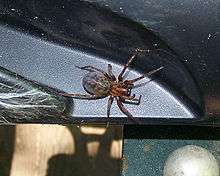Coras (spider)
Coras is a genus of funnel weavers first described by Eugène Simon in 1898.[2] It has fifteen described species that occur in eastern North America from Nova Scotia south to Florida. They can be readily distinguished from other genera in the subfamily by their anterior median eyes being larger than the anterior lateral eyes, whereas in other genera the reverse is true, along with a number of more technical reproductive features. The type species is Coras medicinalis[3] (so named because its web was used in medicine[4]).
| Coras | |
|---|---|
 | |
| C. medicinalis | |
| Scientific classification | |
| Kingdom: | Animalia |
| Phylum: | Arthropoda |
| Subphylum: | Chelicerata |
| Class: | Arachnida |
| Order: | Araneae |
| Infraorder: | Araneomorphae |
| Family: | Agelenidae |
| Genus: | Coras Simon, 1898[1] |
| Type species | |
| C. medicinalis (Hentz, 1821) | |
| Species | |
|
16, see text | |
These spiders are frequently found at or near ground level, or in cellars of houses,[5] where they construct small and rather messy sheet webs on the ground and attached to nearby more elevated things. These webs are small in area and are connected to tubular retreats with simple signal or catching threads radiating from entrance.[6]
The middle eyes in the lower or front row are as large as or larger than the eyes that flank them on the outside. The epigynum has projections at its forward corners. The legs have indistinct gray rings.[7]


Species
As of April 2019 it contains sixteen species:[1]
- Coras aerialis Muma, 1946 – USA
- Coras alabama Muma, 1946 – USA
- Coras angularis Muma, 1944 – USA
- Coras cavernorum Barrows, 1940 – USA
- Coras crescentis Muma, 1944 – USA
- Coras furcatus Muma, 1946 – USA
- Coras juvenilis (Keyserling, 1881) – USA
- Coras kisatchie Muma, 1946 – USA
- Coras lamellosus (Keyserling, 1887) – USA, Canada[8]
- Coras medicinalis (Hentz, 1821) – USA, Canada
- Coras montanus (Emerton, 1890) – USA, Canada
- Coras parallelis Muma, 1944 – USA
- Coras perplexus Muma, 1946 – USA
- Coras seorakensis Seo, 2014 – Korea
- Coras taugynus Chamberlin, 1925 – USA
- Coras tennesseensis Muma, 1946 – USA
References
- "Gen. Coras Simon, 1898". World Spider Catalog. Natural History Museum Bern. Retrieved 2019-05-07.
- Simon, E. (1898). Histoire naturelle des araignées. doi:10.5962/bhl.title.51973.
- Wang, Xin-ping (2002), "A Generic-level Revision of the Spider Subfamily Coelontinae (Araneae, Amaurobiidae)", Bulletin of the American Museum of Natural History (269)
- Hentz, N. M. (1821). "A notice concerning the spiders whose web is used in medicine". Journal of the Academy of Natural Sciences of Philadelphia. 2: 53–55. Retrieved 2016-09-07.
- Kaston, B. J. How to Know the Spiders. p. 172.
- Foelix. Biology of Spiders. p. 122.
- Kaston, B. J. Spiders of Connecticut. pp. 279–281.
- "Ojibway Prairie Complex Checklist of spiders (Araneae), 2014-2015" (PDF). Retrieved 2016-03-18.
| Wikimedia Commons has media related to Coras. |